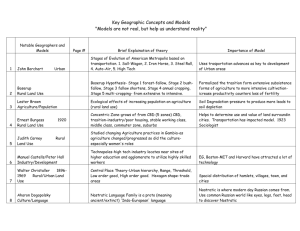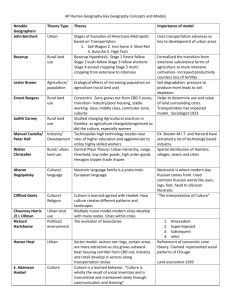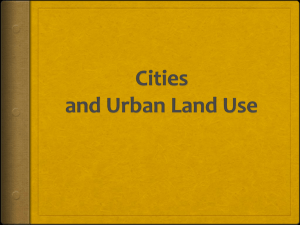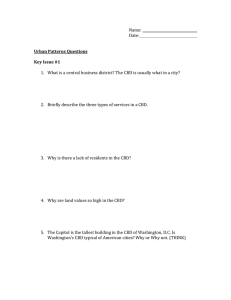File - coach williams' class page
advertisement
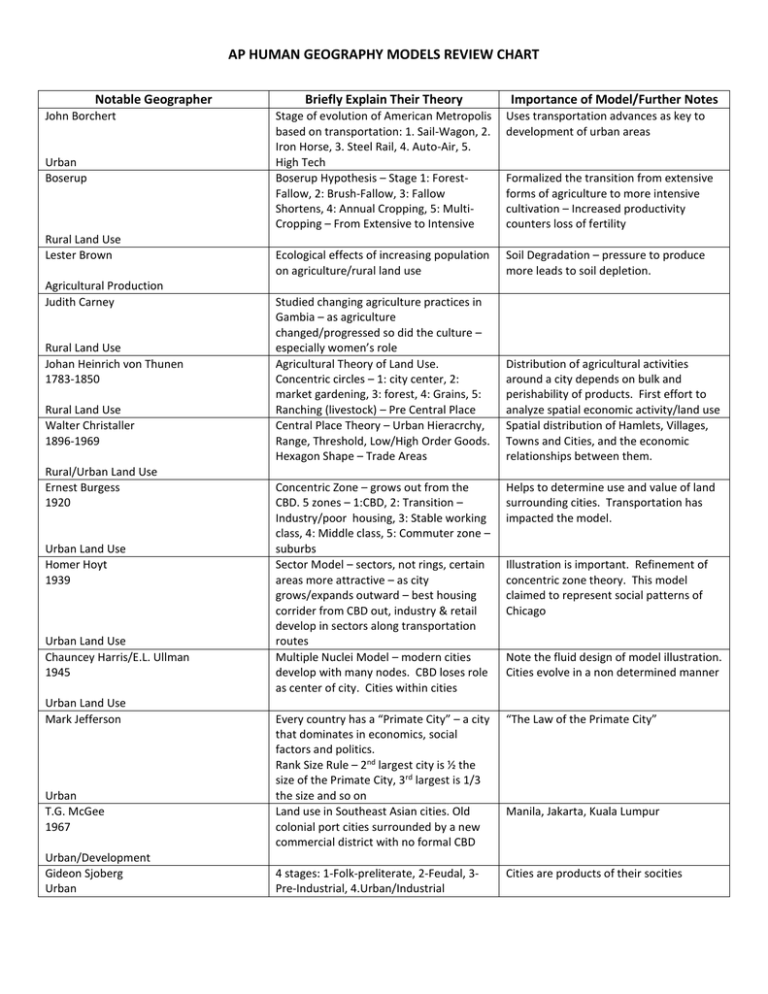
AP HUMAN GEOGRAPHY MODELS REVIEW CHART Notable Geographer John Borchert Urban Boserup Rural Land Use Lester Brown Agricultural Production Judith Carney Rural Land Use Johan Heinrich von Thunen 1783-1850 Rural Land Use Walter Christaller 1896-1969 Rural/Urban Land Use Ernest Burgess 1920 Urban Land Use Homer Hoyt 1939 Urban Land Use Chauncey Harris/E.L. Ullman 1945 Urban Land Use Mark Jefferson Urban T.G. McGee 1967 Urban/Development Gideon Sjoberg Urban Briefly Explain Their Theory Importance of Model/Further Notes Stage of evolution of American Metropolis based on transportation: 1. Sail-Wagon, 2. Iron Horse, 3. Steel Rail, 4. Auto-Air, 5. High Tech Boserup Hypothesis – Stage 1: ForestFallow, 2: Brush-Fallow, 3: Fallow Shortens, 4: Annual Cropping, 5: MultiCropping – From Extensive to Intensive Uses transportation advances as key to development of urban areas Ecological effects of increasing population on agriculture/rural land use Soil Degradation – pressure to produce more leads to soil depletion. Studied changing agriculture practices in Gambia – as agriculture changed/progressed so did the culture – especially women’s role Agricultural Theory of Land Use. Concentric circles – 1: city center, 2: market gardening, 3: forest, 4: Grains, 5: Ranching (livestock) – Pre Central Place Central Place Theory – Urban Hieracrchy, Range, Threshold, Low/High Order Goods. Hexagon Shape – Trade Areas Distribution of agricultural activities around a city depends on bulk and perishability of products. First effort to analyze spatial economic activity/land use Spatial distribution of Hamlets, Villages, Towns and Cities, and the economic relationships between them. Formalized the transition from extensive forms of agriculture to more intensive cultivation – Increased productivity counters loss of fertility Concentric Zone – grows out from the CBD. 5 zones – 1:CBD, 2: Transition – Industry/poor housing, 3: Stable working class, 4: Middle class, 5: Commuter zone – suburbs Sector Model – sectors, not rings, certain areas more attractive – as city grows/expands outward – best housing corrider from CBD out, industry & retail develop in sectors along transportation routes Multiple Nuclei Model – modern cities develop with many nodes. CBD loses role as center of city. Cities within cities Helps to determine use and value of land surrounding cities. Transportation has impacted the model. Every country has a “Primate City” – a city that dominates in economics, social factors and politics. Rank Size Rule – 2nd largest city is ½ the size of the Primate City, 3rd largest is 1/3 the size and so on Land use in Southeast Asian cities. Old colonial port cities surrounded by a new commercial district with no formal CBD “The Law of the Primate City” 4 stages: 1-Folk-preliterate, 2-Feudal, 3Pre-Industrial, 4.Urban/Industrial Cities are products of their socities Illustration is important. Refinement of concentric zone theory. This model claimed to represent social patterns of Chicago Note the fluid design of model illustration. Cities evolve in a non determined manner Manila, Jakarta, Kuala Lumpur AP HUMAN GEOGRAPHY MODELS REVIEW CHART Notable Geographer Immanuel Wallerstein 1970 Development W.W. Rostow 1960 Development Thomas Malthus 1766-1834 Population E.G. Ravenstein Migration Carl Sauer 1889-1975 Culture Vidal De La Blache 1845-1918 Culture Ellsworth Huntington Political/Development Briefly Explain Their Theory Core-Periphery Model: Core/MDC –high socioeconomic level. Periphery/LDC – dependent on core, supplier of raw materials and labor Modernization Model – 5 stages of economic development – 1. Traditional society, 2. Pre-Conditions to take off, 3. Take-off, 4. Maturity, 5. High Mass Consumption Demographic Transition Model Importance of Model/Further Notes Malthusian Theory – Population growth relating to food production. Food grows arithmetically Population grows exponentially Neo Malthusians – Kaplan, Homer-Dixon, Look at Africa Critics – Boserup, Kuznet, Simon, Engels – More people more growth, science will find a way, distribution of wealth, etc. Laws of Migration (11 of them) – 1. Most people migrate for economic reasons, 2. Most long distance migrants are male, 3. Long distance migrants head for major cities Cultural Landscape – Human activity superimposes itself on the physical landscape – each cultural group leaves imprints Possibilism – Human/Environmental Interaction – Humans have a wide range of potential actions within an environment – they respond based on their value systems, attitudes, and cultural attributes Environmental Determinism – Climate and terrain were a major determinate of civilization “The Morphology of Landscape’ The cultural landscape reflects a culture’s values “Principles of Human Geography” Culture determines a peoples response to the environment Temperate climate of Europe lead to greater human efficiency and better standards of living
